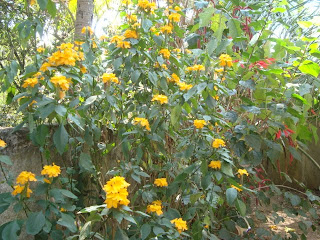
It is summer and one of my favourite flowers, Crossandra, is in full bloom.During this time, it lives up to its popular name - Firecracker flower.
Known as 'Kanakambara' in South India, I'm not sure about its presence in the North.During my growing up years in Bangalore, some street hawkers would give a twist to the name and call out 'Discoambara' while pushing their carts :)
Like the bouganvillea, this plant loves the sun.Since excess watering encourages foliage, watering should be done only when there are visible signs of drooping.Propagation is very easy - cuttings / seeds & not much care is required.


The cultivated flowers are in different shades of orange while the wild flowers are in shades of green. Crossandra has no smell and there are no visible flower parts like pistil, anther, etc. Hence, traditionally, it is not offered to God.
Once upon a time, there were a lot of cultural prejudices against wearing the flower. Identified as the scarlet woman's flower, it was strictly no-no, especially among the women of the upper classes.
Now, of course, there are no such prejudices - even God has started accepting the flowers!
Women of all classes wear it because of the ability of the flower to look fresh for a longer duration. On the plant, the flowers stay fresh for nearly a week.
Often, people ask me about my lack of interest in wearing flowers. Well, I have always preferred flowers on the plants. If I have to wear, then it is a small strand of jasmine, preferably of the Mangalore or the Mysore variety for me. The reason for my jasmine preference - jasmine lives only for a day, whether on the plant, or off it :)
TULLA is a free classified submission site in India, the USA, and global users in 2025. It helps individuals, entrepreneurs, and service providers post unlimited ads, promote businesses, and connect with genuine users. Whether you're buying, selling, renting, or offering services from electronics and jobs to dropshipping and dating TULLA offers a fast, simple, and reliable platform. With its user-friendly interface and wide range of categories, it empowers users to grow their reach, explore new opportunities, and thrive online without spending a rupee. Discover, connect, and succeed with TULLA your go-to destination for deals, visibility, and digital expansion.
ReplyDelete